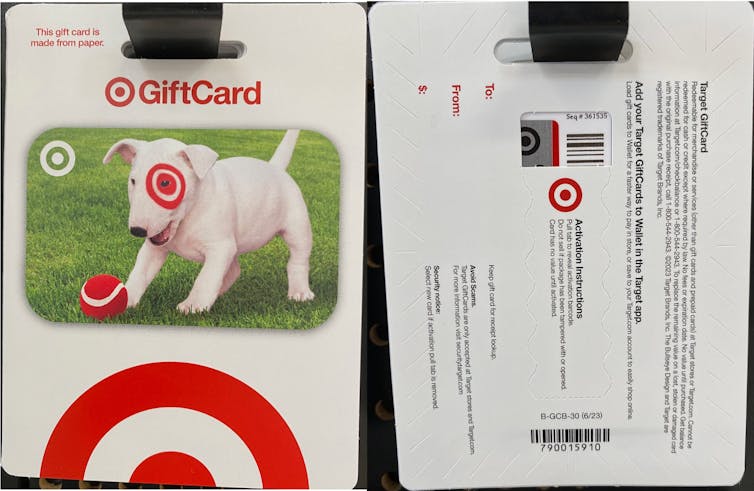How one 83-year-old fell into a fraudster’s fear bubble – and how gift cards played a key role
- Written by Dr. David P. Weber, Professor of the Practice in Fraud and Forensic Accounting, Salisbury University
Wednesday morning, the day before Thanksgiving, Mae awoke, set her hair in curlers and switched on her laptop. A message appeared. It said her Safari web browser had encountered a problem, and a link offered to connect the 83-year-old to the Apple Computer Company. Mae clicked it.
She didn’t know it yet, but Mae, like millions of Americans each year, had fallen into the grip of fraudsters. Over the next 10 hours, the criminals would try several methods to steal her money.
 The drugstore gift card rack used to steal money from Mae.David P. Weber
The drugstore gift card rack used to steal money from Mae.David P. WeberWhat worked best was getting her to buy gift cards. The cards, from retailers such as Target, Apple and Amazon, are sold on racks in drugstores and supermarkets.
They’re better than cash for a fraudster, more portable and just as anonymous. Criminals can use gift card numbers online, at stores around the world, or sell or trade them in illicit marketplaces on the dark web, Telegram or Discord.
An estimated US$8 billion is stolen annually from seniors 60 and older through stranger-perpetrated frauds, according to AARP. The cards are a leading fraud payment method reported by older adults,according to the Federal Trade Commission.
Mae’s story is one of many such cases that prompted us – a fraud and forensic accounting professor who is a former top financial regulator, and a Pulitzer Prize-winning investigative reporter – to explore how cracks in the financial regulatory system dating to the Civil War have been exploited by fraudsters and corporations.
The investigation shows that federal regulators haven’t protected the public from gift card fraud, and Congress has largely deferred to regulators. State and federal efforts to rein in the industry have been opposed by lobbyists and gift card trade groups. And gift card retailers are often not helpful in assisting law enforcement.
 One of many Telegram ads offering gift cards from many different common providers at a deep discount.SOCRadar
One of many Telegram ads offering gift cards from many different common providers at a deep discount.SOCRadarOne of us learned about Mae’s case in his work as a fraud examiner and has seen dozens of similar cases. Mae, who lives in Maryland, is unwilling to publish her last name, but she wants people to know her story so they don’t make the same mistakes.
In gift card fraud, everybody but the victim makes money: fraudsters, gift card companies and retailers. The criminals exploit a rapidly evolving payments industry that’s shrouded in secrecy and designed to ensure easy transactions.
Call this number
When Mae called the number that appeared on her screen, a man answered and identified himself as Mac Morgan, an “Apple high-security technician.” The problem seemed to originate from her bank, he told her. She volunteered that she banked with M&T, a Northeast bank headquartered in Buffalo, New York. Call them, he said, and provided a phone number.
The woman who answered said her name was Alivia, from the M&T Bank Fraud Unit. Alivia told Mae that a European pornographer and scammer had tried to gain access to her account and withdraw $20,000 during the night. A hold had been placed on the withdrawal, but Mae needed to come down to the bank and retrieve the money before the fraudsters did.
Alivia promised to stay on the phone with Mae throughout the process.
Gift cards are the latest in fraudsters’ arsenal of tools to steal money from people through deceptions such as romance scams, fake IRS notices and phony investment schemes.
The average reported amount lost is $1,000, but between 2021 and 2022 more than 100 consumers reported gift card fraud losses in excess of $400,000, according to an FTC public records request. About $550 billion is added onto gift cards annually in the U.S., according to Jordan Hirschfield, a gift card analyst at Javelin Strategy & Research. He estimates that between 1% and 5% of gift card sales could involve fraud, but because no one keeps track, it’s difficult to arrive at an exact number. If the 1% to 5% figure is correct, it’s between $5.5 billion and $27.5 billion per year.
A victim’s fear bubble
Mae had entered a fear bubble, an induced state of panic that makes rational thought difficult.
Anyone can fall victim. Mae had graduated summa cum laude from an elite private university. She is a no-nonsense retired nurse and lives independently. Now she was rushing, panicked, to her bank at the direction of a fraudster.
At the bank, the teller and manager tried to dissuade Mae from withdrawing $20,000 in cash. After about 15 minutes, she wore them down.
In Maryland, the bank had no option but to give Mae her money. That’s not the case in other states. In Florida, a state that contends with elevated incidents of fraud on seniors, the Legislature passed a law in May allowing financial institutions to delay transactions to people over 65 if there is a well-founded belief of exploitation.
Anecdotal evidence from law enforcement suggests that even a few hours of delay can pop the fear bubble fraudsters create.
Several states have passed or are considering laws requiring gift card warning signs, including Delaware, Iowa, Nebraska, Pennsylvania, Rhode Island and West Virginia.
Next, Alivia directed Mae to a Cash2Bitcoin ATM at a gas station and talked her through registering, including uploading her driver’s license, a know-your-customer requirement that doesn’t exist for gift cards. Mae fed thousands of dollars into the machine. At $15,000, the ATM hit its limit on deposits.
Alivia then passed the phone to a colleague, Ross, who directed Mae to buy gift cards. At Rite Aid, Mae bought four cards for $2,000, scratched the backs of the cards and read the numbers to Ross.
 The front and back of a Target gift card. Removing the cardboard tab uncovers a scratch-off area; scratching reveals the card numbers. Once a fraudster has the numbers, the money on the card can be quickly spent online.The Conversation, CC BY-ND
The front and back of a Target gift card. Removing the cardboard tab uncovers a scratch-off area; scratching reveals the card numbers. Once a fraudster has the numbers, the money on the card can be quickly spent online.The Conversation, CC BY-NDBut at the Food Lion supermarket, a manager who knew her refused to sell her any gift cards. Ross gave up and instructed her to go home but not tell anyone what had transpired.
Gift card companies claim to be “highly regulated” because Congress passed the Credit CARD Act in 2009. This eliminated many fees on gift cards, prohibited them from expiring for at least five years and allowed state law to preempt federal law. But it didn’t extend existing credit and debit card consumer fraud protections.
In 2010, Congress created a single regulator for consumer financial protection: the Consumer Financial Protection Bureau. But the agency hasn’t kept up with the rise in consumer financial products outside of banks. Rules it issued in 2016 and 2018 exempted most gift cards from regulation. The FTC and Treasury Department have also proven ineffective in combating the problem.
The fear bubble pops
By the time Mae pulled into her driveway, the ether had lifted. “It was a big fat light bulb: ‘You’ve been screwed,’” she said.
Mae called M&T: There was no open fraud case. She called Target: The gift cards had already been spent. Mae got most of her bitcoin money back, thanks to the compliance efforts and fraud freeze on her account on the day of the fraud. But the gift card money was gone.
Fraud against the elderly, including through gift cards, will likely continue to grow.
Mae reported her story to the local police, AARP and the FTC database. “It can happen to anyone,” she said.
For the full investigation, please visit: Gift card scams generate billions for fraudsters and industry as regulators fail to protect consumers − and how one 83-year-old fell into the ‘fear bubble’
Dr. David P. Weber receives funding from the Administration for Community Living (ACL), U.S. Department of Health and Human Services (HHS) to combat elder financial and high tech exploitation on the Eastern Shore of the Chesapeake Bay, Maryland. The award totals $2.6 million of financial assistance, with 80 percent funded by ACL/HHS and 20 percent funded by Maryland state and local government sources. The contents of this investigative story are those of the authors and do not necessarily represent the official views of, nor an endorsement, by ACL/HHS, or the U.S. Government.
Jake Bernstein does not work for, consult, own shares in or receive funding from any company or organization that would benefit from this article, and has disclosed no relevant affiliations beyond their academic appointment.
Authors: Dr. David P. Weber, Professor of the Practice in Fraud and Forensic Accounting, Salisbury University
